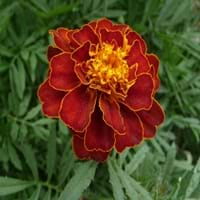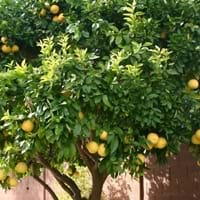Life Span
Annual
Perennial
Type
Flowering Plants, Shrubs
Fruit
Origin
Mexico, Central America
South Asia, Southeast Asia
Types
African or American Marigolds, French Marigolds, Mule Marigolds
Not Available
Number of Varieties
Not Available
Habitat
Roadsides, wastelands
Mediterranean region
USDA Hardiness Zone
9-11
8-10
AHS Heat Zone
12 - 1
Not Available
Sunset Zone
A1, A2, A3, H1, H2, 1a, 1b, 2a, 2b, 3a, 3b, 4, 5, 6, 7, 8, 9, 10, 11, 12, 13, 14, 15, 16, 17, 18, 19, 20, 21, 22, 23, 24
Not Available
Habit
Clump-Forming
Spreading
Flower Color
Yellow, Red, Orange, Gold, Dark Red, Orange Red
White
Flower Color Modifier
Bicolor
Bicolor
Fruit Color
Brown
Green, Lemon yellow, Yellow
Leaf Color in Spring
Dark Green
Green
Leaf Color in Summer
Dark Green
Green
Leaf Color in Fall
Dark Green, Burgundy
Dark Green
Leaf Color in Winter
Light Green
Dark Green
Plant Season
Summer, Fall
All year
Sunlight
Full Sun
Full Sun
Type of Soil
Loam, Sand
Rich
The pH of Soil
Acidic, Neutral, Alkaline
Acidic
Soil Drainage
Well drained
Well drained
Bloom Time
Early Summer, Summer, Late Summer, Early Fall, Fall, Late Fall
Spring, Summer
Tolerances
Drought
Full Sun
Where to Plant?
Container, Ground, Pot
Container, Ground
How to Plant?
Seedlings
Divison, Seedlings
Plant Maintenance
Medium
High
Watering Requirements
Allow soil to be completely dry in between waterings, Form a Soil ring to water efficiently, Keep the ground moist but not water-logged, Water in morning to avoid prompting diseases, Water when soil is dry
Reduce watering once fruit are growing, Water daily during growing season
In Summer
Lots of watering
Lots of watering
In Spring
Moderate
Moderate
In Winter
Average Water
Average Water
Soil pH
Neutral, Slightly Alkaline
Acidic
Soil Type
Well drained
Rich
Soil Drainage Capacity
Well drained
Well drained
Sun Exposure
Full Sun, Part sun
Full Sun
Pruning
Prune ocassionally, Remove dead or diseased plant parts, Requires little pruning
Prune to control growth, Remove dead branches
Fertilizers
All-Purpose Liquid Fertilizer
Fertilize in early to mid-summer, for fruiting plants, use high phosphorous content fertilizer
Pests and Diseases
Alternaria Leaf Spot, Bacterial leaf spot, Damping-off, Gray mold, Powdery mildew, Root rot
Aphids, Citrus foot rot, Citrus gummosis, Citrus leaf miner, Red blotch
Plant Tolerance
Drought
Full Sun
Flower Petal Number
Single, Double, Semi-Double
Double, Semi-Double
Fragrant Bark/Stem
Yes
No
Foliage Texture
Fine
Coarse
Foliage Sheen
Matte
Glossy
Attracts
Butterflies
Ants, Birds
Allergy
no allergic reactions
Anaphylaxis, Cough, Nausea, Rhinitis, Stomach pain, Swelling, Urticaria, Vomiting, wheezing
Aesthetic Uses
Showy Purposes
Farmland, Showy Purposes
Beauty Benefits
Not Available
Acne, Good for skin, Good for the Scalp, Improve skin tone, Moisturizing, Strong, beautiful hair
Environmental Uses
Air purification
Food for animals, Very little waste
Medicinal Uses
Burns, constipation, Inflammation, Upset stomach, Wounds
anti-cancer, constipation, Digestive, Gastrointestinal disorders, Gout, Immunity, Jaundice, Respiratory Disorders, Rheumatoid arthritis, scurvy, Ulcers, Urinary problems, Weight loss
Part of Plant Used
Flowers, Seeds
Fruits
Other Uses
Can be made into a herbal tea, Decoration Purposes, Used As Food
Cosmetics, Used as a flavouring in food, Used As Food, Used for its medicinal properties
Used As Indoor Plant
Yes
No
Used As Outdoor Plant
Yes
Yes
Garden Design
Bedding Plant, Edging, Foundation, Houseplant, Mixed Border
Edible, Fruit Tree, Tropical
Botanical Name
TAGETES patula
Citrus limetta
Common Name
French Marigold
sweet lime, sweet lemon, sweet limetta
In Hindi
फ्रेंच गेंदा
मौसम्बी
In German
Französisch Marigold
süße Limone
In French
Marigold français
Citrus limetta
In Spanish
Marigold francés
limetta dulce, limón dulce mediterráneo, limón dulce y lima dulce
In Greek
Γαλλικά Marigold
γλυκό ασβέστη
In Portuguese
Marigold Francês
doce de limão
In Polish
francuski Marigold
słodkie limonki
In Latin
French Zinnia
dulcis ad cinerem
Phylum
Tracheophyta
Magnoliophyta
Class
Magnoliopsida
Magnoliopsida
Order
Asterales
Sapindales
Family
Asteraceae
Rutaceae
Clade
Not Available
Not Available
Tribe
Not Available
Citreae
Subfamily
Not Available
Citroideae
Season and Care of French Marigold and Sweet Lime
Season and care of French Marigold and Sweet Lime is important to know. While considering everything about French Marigold and Sweet Lime Care, growing season is an essential factor. French Marigold season is Summer and Fall and Sweet Lime season is Summer and Fall. The type of soil for French Marigold is Loam, Sand and for Sweet Lime is Rich while the PH of soil for French Marigold is Acidic, Neutral, Alkaline and for Sweet Lime is Acidic.
French Marigold and Sweet Lime Physical Information
French Marigold and Sweet Lime physical information is very important for comparison. French Marigold height is 15.20 cm and width 15.20 cm whereas Sweet Lime height is 800.00 cm and width 600.00 cm. The color specification of French Marigold and Sweet Lime are as follows:
French Marigold flower color: Yellow, Red, Orange, Gold, Dark Red and Orange Red
French Marigold leaf color: Dark Green
Sweet Lime flower color: White
- Sweet Lime leaf color: Green
Care of French Marigold and Sweet Lime
Care of French Marigold and Sweet Lime include pruning, fertilizers, watering etc. French Marigold pruning is done Prune ocassionally, Remove dead or diseased plant parts and Requires little pruning and Sweet Lime pruning is done Prune to control growth and Remove dead branches. In summer French Marigold needs Lots of watering and in winter, it needs Average Water. Whereas, in summer Sweet Lime needs Lots of watering and in winter, it needs Average Water.





